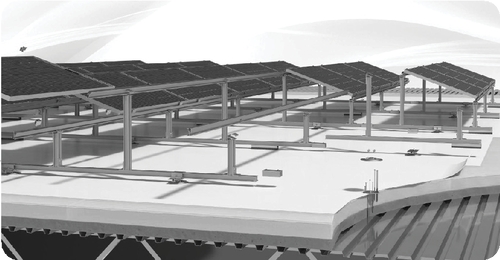Low Load-Bearing Flat Roofs: How the Right Racking Enables Smart Project Management
25 March 2025

Flat roofs with limited load-bearing capacity often pose a significant challenge for solar energy projects. Traditional racking systems often lack flexibility, leading to costly structural reinforcements for the roof or, in some cases, project cancellations. However, with innovative racking solutions specifically designed to optimize weight distribution and adaptability, solar installations on such rooftops are now more feasible than ever.
Tailor-Made Designs to Meet Project-Specific Constraints
Every solar project presents unique challenges, especially when it comes to flat roofs with limited structural capacity. A tailor-made racking design allows these challenges to be addressed effectively. Unlike conventional solutions, these customized systems adapt to the building's structure and environmental conditions, optimizing space usage and energy output without compromising the roof's integrity.
These solutions offer essential flexibility, enabling adjustments based on the roof's specific constraints. This approach reduces the need for unnecessary structural modifications and ensures a successful and efficient solar installation.
Ultra-Optimized Load Distribution for Maximum Compatibility
One of the key innovations in modern solar racking solutions is ultra-optimized load distribution. By leveraging rail-based systems, weight can be strategically allocated across structural elements such as beams, purlins, or rafters, minimizing stress on weak points.
This intelligent distribution reduces pressure on the roof and eliminates the need for additional reinforcement. For instance, engineered aluminium rail systems allow for superior load balancing, ensuring that even low load-bearing flat roofs can support solar arrays efficiently, while ensuring longevity for the system.
Compliance and Adaptability: Ensuring Long-Term Success
Beyond structural considerations, compliance with industry standards is crucial for solar installations. Advanced simulation tools play a vital role in ensuring that each installation meets regulatory requirements while adapting to specific roof conditions.
Utilizing cutting-edge modeling and simulation tools developed around the specific rail system is now mandatory to fine-tune installations. By that, taking into account wind loads, snow accumulation, and local building codes while taking into account the type of flat roof racking used is mandatory. This ensures not only compliance, feasibility but also longevity and performance optimization for each solar system.
A Smarter Approach to Flat Roof Solar Projects
Installing solar panels on flat roofs with limited load capacity is no longer an insurmountable challenge. Through tailor-made racking designs, ultra-optimized load distribution, and compliance-driven adaptability, building owners can leverage solar energy without costly structural upgrades or waybacks.
With innovative solutions like aluminium rail rackings, the transition to renewable energy becomes more accessible, efficient, and cost-effective for businesses and property developers alike.